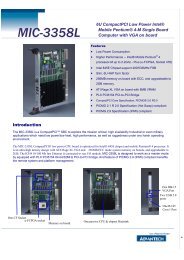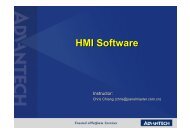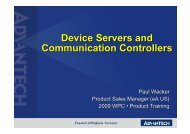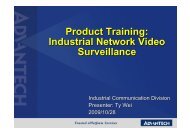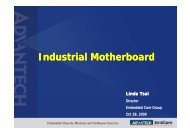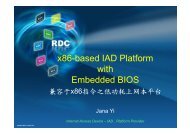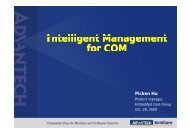industrial wireless book special edition - Networking ...
industrial wireless book special edition - Networking ...
industrial wireless book special edition - Networking ...
You also want an ePaper? Increase the reach of your titles
YUMPU automatically turns print PDFs into web optimized ePapers that Google loves.
I n d u s t r i a l W i r e l e s s<br />
Fig. 2. An ISA100.11a-compatible flexible network: The infrastructure meshing network will cover most of the site's<br />
area and the field device meshing network will connect remote devices to the high-speed infrastructure meshing network<br />
via one or two battery-powered routing field devices.<br />
meshing network. That is why Honeywell<br />
recommends field device meshing topologies<br />
for applications requiring slow reporting rates<br />
from the field, and infrastructure meshing<br />
topologies for applications requiring fast<br />
reporting rates from the field.<br />
Battery life. In a field device meshing<br />
topology, routing transmitters have to actively<br />
listen and send data to neighbouring transmitters.<br />
The battery life of a transmitter is a<br />
function of the number of transmitters meshed<br />
with the device. It decreases as the number of<br />
meshed transmitters increases. In an infrastructure<br />
topology, transmitters send data to<br />
routing infrastructure devices. This translates<br />
into a significant difference between the<br />
battery life of a transmitter acting as a routing<br />
node in a field device meshing topology, and<br />
a transmitter in an infrastructure meshing<br />
topology.<br />
Honeywell recommends field device meshing<br />
topologies for applications requiring slow<br />
reporting rates, and for plants not planning to<br />
scale up to tens of transmitters. Infrastructure<br />
meshing topologies are suitable for applications<br />
requiring fast reporting rates and<br />
millisecond latency, and for plants planning to<br />
scale up to hundreds of transmitters.<br />
Reporting rate. In order to avoid frequent<br />
replacement of batteries, routing transmitters<br />
are only used for applications requiring slow<br />
reporting rates. A non-routing transmitter in<br />
an infrastructure meshing topology can be<br />
configured at the highest reporting rate. Some<br />
transmitters can report as fast as a 1-second<br />
update rate.<br />
Honeywell recommends field device meshing<br />
topologies with ISA100.11a field instruments<br />
for users with applications requiring slow<br />
update rates (30 seconds or more). For applications<br />
requiring fast update rates, it<br />
recommends an infrastructure meshing<br />
topology with either Multinodes or Field Device<br />
Access Points (see box).<br />
Scalability. Routing transmitters can route<br />
a limited number of field instruments. This<br />
limitation is primarily because of the 802.15.4<br />
radio. This has a 250 kps throughput, which is<br />
just sufficient to route data from a handful of<br />
transmitters. The other limitation is because<br />
of the components selected for use with<br />
<strong>wireless</strong> field instruments. Power consumption<br />
and management are key requirements driven<br />
by customers' need to have <strong>wireless</strong> field instruments<br />
with multi-year (10 years) battery life.<br />
The components are selected based on their<br />
power consumption and power management<br />
capability. This typically means a small memory<br />
and computing footprint, which differs from<br />
line-powered routing infrastructure devices<br />
where power consumption and power<br />
management are not an issue. Wireless field<br />
instruments can route up to four transmitters<br />
efficiently, while routing infrastructure nodes<br />
can route up to 80 transmitters.<br />
Flexibility. Field device meshing topology<br />
limits users to an ISA100.11a field instrumentsbased<br />
application. An infrastructure meshing<br />
topology having <strong>industrial</strong> meshing access<br />
points designed to extend the process control<br />
network into the field, can support ISA100.11a<br />
field instruments and Wi-Fi devices, and<br />
therefore enable a multitude of applications.<br />
Such devices (Multinodes) can simultaneously<br />
route data between Wi-Fi (IEEE 802.11 b/g)<br />
clients, ISA100.11a field instruments and<br />
Ethernet/IP devices and host applications.<br />
It is possible to start small with a field device<br />
meshing network and scale up to an infrastructure<br />
meshing network. Most installations will be<br />
a combination of infrastructure meshing and<br />
field device meshing networks. The infrastructure<br />
meshing network will cover most of the site's<br />
area and the field device meshing network will<br />
be used to connect remote devices to the highspeed<br />
infrastructure meshing network via one<br />
or two battery-powered routing field devices.<br />
Figure 2 shows the Honeywell implementation<br />
of an ISA100.11a-compatible network.<br />
And finally…<br />
Automation professionals should carefully<br />
consider their current and future needs prior<br />
to selecting an <strong>industrial</strong> <strong>wireless</strong> system.<br />
Certain applications are ideal for infrastructure<br />
meshing networks, while others are more suited<br />
to field device meshing networks. To gain the<br />
maximum benefit that meshing can offer, the<br />
selected system should support both topologies<br />
simultaneously and seamlessly in a single<br />
network.<br />
Current market trends indicate that most<br />
installed <strong>wireless</strong> systems will use infrastructure<br />
meshing complemented by field device meshing<br />
when infrastructure meshing is installed at the<br />
core of the plant where power is readily<br />
available. Field device meshing is used in<br />
remote areas of the plant where power is not<br />
readily available.<br />
32<br />
Field Device Meshing<br />
Infrastructure Meshing<br />
Latency 100ms/hop 20ms/hop<br />
Fastest recommended reporting<br />
rate for field instruments<br />
30 seconds 1 second<br />
Routing capability<br />
Four transmitters at 30 seconds<br />
20 transmitters at 1-second or 80<br />
transmitters at 5 seconds<br />
Field instrument battery life<br />



